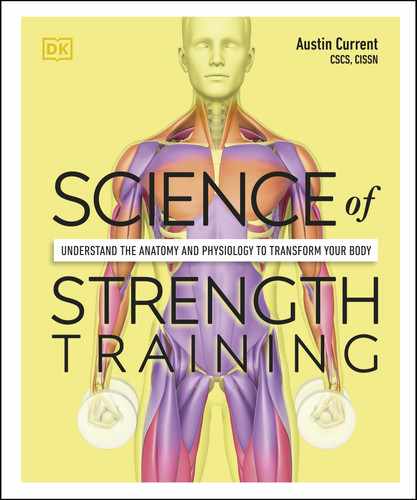wide-grip vertical pulldown
Vertical pulling is a great exercise for supporting good posture and general mobility. The wide grip used in this variation of the exercise puts the focus on the muscles of the upper back and the latissimus dorsi, as well as training the biceps and rear deltoid muscles of the upper arm and shoulder.
the big picture
A wide grip on the bar targets the upper back, whereas a more neutral grip works the lats and biceps more; to discover how a change of grip tweaks the muscles worked, see Wide-grip Vertical pulldown Variations. If you experience joint discomfort during this exercise, try adjusting your range of motion in stage 2 to place less stress on the shoulder joint.
Beginners can start with 4 sets of 8–10 reps; discover other variations to practice at home and other targeted sets in the training programs.
PREPARATORY STAGE
Set the weights and adjust the seat height. Slide your thighs under the leg pad and sit with your knees bent and feet flat on the floor. Take hold of the bar and lean your torso back a little, slightly extending your upper back.

n Double-tap image to read the labels
stage one
Breathe in and engage your abs to stabilize and tighten your core. As you breathe out, pull the bar down by flexing at the elbows and contracting the muscles of your upper/mid back; your elbows will be driven outward. Keep your chest high and pull the bar toward the top of your sternum. (It doesn’t have to touch you.)

n Double-tap image to read the labels
POSTERIOR-LATERAL VIEW
Upper body and arms
Muscles of the upper back, such as the teres, rhomboids, trapezius, rear deltoids, latissimus dorsi, and biceps, are targeted in this exercise. Control the eccentric action (stage 2) of the movement by maintaining tension in the muscles of your back rather than letting your biceps take over.
Legs
The muscles of the lower body help provide your base of support during this move. In this pulldown, stability comes from your leg (which is in contact with the thigh pad), allowing more tension to be placed on the target muscles. If needed, place a weight plate under each foot to maintain contact with the ground.
stage two
Keeping your abs engaged, breathe in to return the bar to the starting position, with control; keep tension in your back and biceps throughout. Reset your breathing and repeat stages 1 and 2. To add a challenge, pause for 1–2 seconds at the top or bottom position.

n Double-tap image to read the labels
